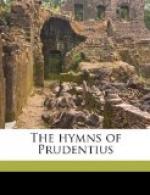increase of the sun’s light, which begins after the winter solstice,
as symbolic of the ever-widening influence of the True Light. The
idea is given in a terse form by St. Peter Chrysologus, Serm. 159:
Crescere dies coepit, quia verus dies illuxit. “The day begins to
lengthen out, inasmuch as the true Day hath shone forth.”
18 For the somewhat obscure phrase verbo editus, see note on iii. 2.
20 For “Sophia” or the Divine Creative
Wisdom, see Prov. iii. 19, 20,
and especially viii.
27-31, where the language “has been of signal
importance in the history
of thought, helping, as it does, to make
a bridge between Eastern
and Greek ideas, and to prepare the way
for the Incarnation”
(Davison, Wisdom-Literature of the O. T., pp.
5, 6). In Alexandrian
theology the conception of God’s transcendence
gave rise to the doctrine
of an intermediate power or logos, by
which creation was effected.
In the Prologue of the fourth Gospel
the idea was set forth
in its purely Christian form. See 1, 3, where
the Logos or the pre-incarnate
Christ is described as the maker of
all things—an
idea which is also illustrated by the language of St.
Paul in such passages
as Col. i. 6.
59 Cf. for the conception of a golden age, Virg.,
Ecl., iv. 5
et seq.:
Magnus ab integro saeclorum nascitur ordo, etc.
65 Reminiscences of ancient prophecy appear to
be embodied in this
and following lines.
Cf. Joel iii. 18: “And it shall come
to pass
in that day that the
mountains shall drop down sweet wine and the
hills shall flow with
milk.” Amos ix. 13: “The mountains
shall drop
sweet wine and all the
hills shall melt.” But cf. especially Virg.,
Ecl., iv. 18-30:
At tibi prima, puer, nullo munuscula cultu,
etc.
“Unbidden earth shall
wreathing ivy bring,
And fragrant herbs (the promises of spring)
As her first off’rings to her infant
king.
* * * * *
Unlaboured harvest shall the fields adorn,
And clustered grapes shall blush on every thorn;
The knotted oaks shall showers of honey weep,
And through the matted grass the liquid gold shall creep.”
(Dryden’s Trans.)
81 The legend of the ox and ass adoring our Lord
arose from an
allegorical interpretation
of Isa. i. 3: “The ox knoweth his owner,
the ass his master’s
crib.” Origen (Homilies on St. Luke
xiii.)
is the first to allegorise
on the passage in Isaiah, where the word
for “crib”
in the Greek translation of the O. T. is identical




